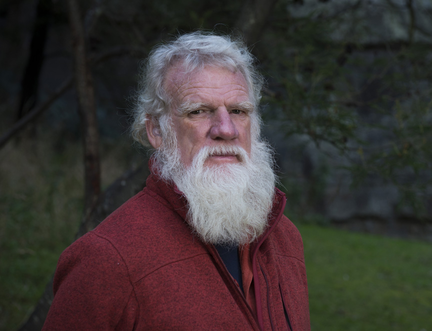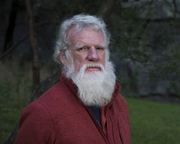The Ascent of Woman
By Bruce Pascoe

In 2018, we commissioned 51 authors from 25 countries to write essays exploring ideas about freedom for The Freedom Papers, a publication produced in partnership with Gutter Magazine. Read on for Bruce Pascoe's essay, and visit guttermag.co.uk to purchase a copy of The Freedom Papers.
You climb the mountain in silence. Each member of the group is introduced to the mountain with a single clap of the sticks. There is a lyrebird listening and he will repeat the number of those claps exactly. The numerate lyrebird. This is Ngaran Ngaran and like all lyrebirds his default call is indistinguishable from the clap of the sticks.
There was a period of eighty years when the birds stopped hearing that sound generated by humans but about twenty years ago the ritual began again and the lyrebird, who wasn’t around when the clapsticks stopped, registered the sound as part of its own voice.
Interesting avian skill or part of the mountain’s spirit? An old man, himself initiated by one of the great spiritual leaders, introduces the mountain climbers to the seven chapters of his lore.
The group gathers about the creation rock where they are asked to think of everyone; the sick, the lame, the sad, the lonely and especially the unborn child, everyone but themselves. Then they are introduced to Nyaadi and Tunku, the first woman and the first man. Nyaadi is a granite tor and towers over Tunku. The gifts bestowed on them by Baiame or Dharama, the great creator, are a rock and a tree, from which everything they needed could be created.
We pass by the pregnant mother and we’re asked to put our hand on her belly, an exquisite intimacy with the earth. We pass by the three rocks of eternity, the past, the future and the present and we’re asked to concentrate on the larger mass of the three parts of that rock, the now. Be informed by the past, work toward the future but live in the now.
So much of the spirituality is about the care of the Mother and if something disappears it is we who have to ask ourselves, what did we do wrong?
The answer to that may be something as simple and profound as our greed to dredge the seagrass beds for scallops. Not happy to pick that shellfish from between the weeds our economy insists on ploughing the seafloor, to rape our mother.
As you leave the corridor of tors your presence is clapped from the mountain by the sticks while the lyrebird, Ngaran Ngaran listens, to ensure all are accounted for, that no spirit remains where it does not have the right to dwell. Not very long ago an old man spent two nights in the cave next to the birth canal and his dream there ensured the spirit of the mountain was made safe. We must never defy or defile that dream.
While walking back down the mountain you will realise that in the explanation of the earth’s spirit you did not see a weapon.
This philosophic statement is not like the church in Venice where there is a depiction of molten lead being poured into the mouth of a blasphemer or the Blue Mosque in Istanbul where a man has his hands cut off for stealing food, or the Portuguese mural where Vasco da Gama’s ambition to dominate the Indian spice trade led him to humiliate those he conquered by cutting off their ears and replacing them with those of a dog.
No, it is not like that because this lore was wrought at least 80,000 years after the ancestor spirits, Baiame and Dharama created all the mountains and rivers, all the bandicoots and glossy black cockatoos, and eventually men and women. Baiame explained to those first two that while they were the first people they we no better than ants, no more deserving of the earth than a dead twig on a desert oak.
No, Baiame taught them the lore and told them to uphold their lore and they did because they could see the reasonableness of Baiame’s stricture. The men went to their fire and thought about it and the women went to their fire and thought about it, many nights they talked and thought, they lay in their possum skins on winter nights and stared up into the brilliant sky and saw their ancestors, the dark emu and the black duck, the dog and the nankeen kestrel, the possum and the snake.
The men joined the women at the great circle and there they were painted with designs of universal importance and then they danced and sang and sang and danced their understanding of the universe.
Yes, those old people danced and after they danced man lay down with woman. The woman felt the back of the man’s neck, the two long rigid tendons there, she pushed her fingers into his hair and pulled his face down to her face, she tasted his mouth, with her tongue, he slid his hand down her flank and realised the wonder of the scoop of her waist and the swelling of her arse. And they were happy. For that is the lore.
And of course within the lore there are little spirits of the water who creep into a woman after she has stared into the face of a selected man and those little slippery imps squirm in the fluid of her, clench and unclench their fists, punch out with their heels, just because they want to, and oomph that woman feels the spirit within her. For that is the lore.
And that man and that woman and all the other men and women of the campfires, their faces still hot from their entanglements on possum skin, talk about their humanity, how they can be cruel and violent, kind and generous, thoughtful and wise, dumb and greedy, and they know that the little slippery spirit within her will be born with all those possibilities, but that it was their job to teach that little slippery imp so that she would know the lore; that it was better to be generous than greedy, kind than cruel, gentle than violent, for why would you choose otherwise?
They decided that all people would be fed, all would be housed, all would share in the culture, yes, all would pound the interlocking circles with their dancing feet, all would learn, every day they would learn, and when they were old younger people would bring them water and love, the young people would bring those staggery wrecks love and respect, because the young believed in the lore taught to them by those same stumbly totterers. That is how morality survives.
Copyright © 2018, Bruce Pascoe. All rights reserved.
Supported by the Scottish Government’s Edinburgh Festivals Expo Fund through Creative Scotland.
Look, Listen & Read
- 2026 Festival:
- 15-30 August
Latest News
 Major new partnership with Celtic Connections
Major new partnership with Celtic Connections




